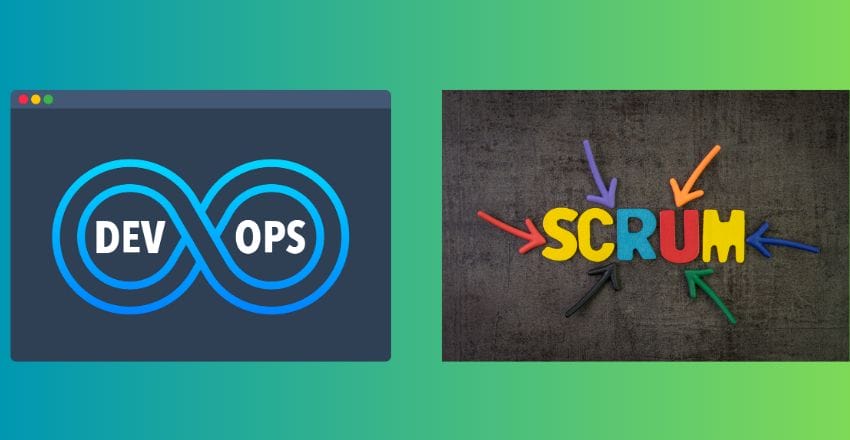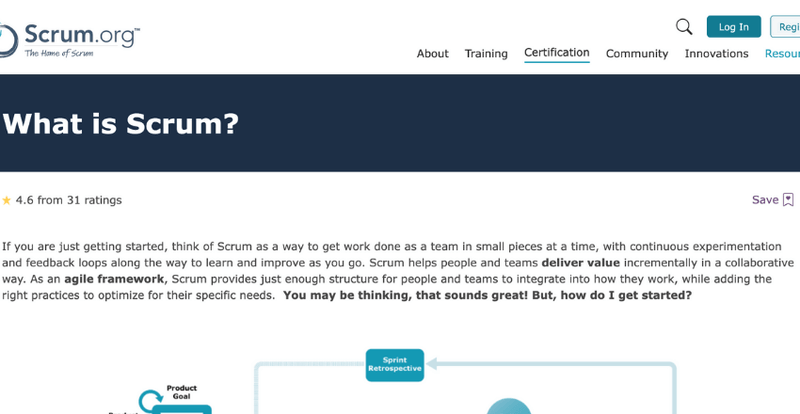
DevOps and Scrum streamline software development, ensuring faster delivery, enhanced collaboration, and robust quality.
In today’s fast-paced and ever-changing IT landscape, it is essential for organizations to optimize their software development process to remain competitive. Many have turned to DevOps and Scrum methodologies, which individually offer significant benefits in terms of agility, collaboration, and continuous improvement.
Key Takeaways
- Integrating DevOps and Scrum can result in enhanced efficiency and collaboration.
- DevOps focuses on principles such as continuous integration, deployment automation, and infrastructure as code.
- Scrum promotes collaboration and iterative development with its frameworks, roles, and ceremonies.
- Successfully integrating Scrum in a DevOps environment requires aligning sprints with DevOps release cycles, integrating cross-functional teams, and leveraging automation tools.
- Continuous integration, deployment, and feedback loops play a crucial role in Scrum and DevOps projects.
Understanding DevOps and Scrum
DevOps and Scrum elevate efficiency and collaboration in IT, each contributing unique yet complementary Agile principles. This compatibility makes them a perfect fit for numerous teams.
DevOps concentrates on software development, deployment, and maintenance, emphasizing continuous integration, delivery, and feedback. When teams implement key strategies like automated testing, infrastructure as code, and deployment automation, they shorten development cycles, decrease error rates, and boost software reliability.
Conversely, Scrum functions as an Agile project management framework that values collaboration, flexibility, and iterative development. Scrum teams participate in sprints, typically spanning 2-4 weeks, to accomplish prioritized tasks. Each sprint ends with a retrospective, giving the team an opportunity to evaluate their performance and fine-tune upcoming sprints.
While DevOps and Scrum have distinct focuses, they share a common goal: the swift and efficient delivery of high-quality software. By integrating these methodologies, teams can capitalize on the strengths of both, optimizing their IT projects.
Key Principles of DevOps
DevOps is a set of practices that emphasizes collaboration and communication between development and operations teams, with the goal of delivering applications and services more quickly, reliably, and frequently. To achieve these outcomes, DevOps relies on a set of key principles and practices.
Continuous Integration
Continuous Integration (CI) automates the building and testing of code changes, integrating them into a shared repository. CI detects errors early in development and safeguards the application from adverse code changes.
To implement CI, you can employ a build server that auto-compiles and tests code changes. Configure this server to run tests and additional checks, then relay feedback to developers. Leveraging this feedback enables developers to swiftly pinpoint and resolve issues before they escalate.
Deployment Automation
Deployment automation utilizes automated tools to deploy applications and infrastructure, minimizing human error and accelerating the release cycle.
For instance, you can use scripts to configure servers and install software. By placing these scripts under version control, testing them, and deploying them consistently, you reduce error risks and ensure the application maintains a consistent state across various environments.
Infrastructure as Code
Infrastructure as Code (IaC) involves defining infrastructure through code, allowing teams to automate provisioning and configuration and treat infrastructure as a version-controlled asset.
With IaC, teams manage infrastructure like code, writing tests, conducting code reviews, and utilizing version control tools. This ensures controlled and consistent infrastructure changes.
In summary, DevOps’ key principles aim to enhance team collaboration, automate repetitive tasks, and deliver top-quality applications and services. Adopting these principles boosts efficiency, cuts down errors, and speeds up value delivery to customers.
Scrum

Scrum serves as an Agile framework that fosters iterative development and project management. It incorporates specific roles, ceremonies, and artifacts to enhance collaboration, transparency, and continuous improvement. Commonly employed in software development, Scrum can also integrate with DevOps practices to boost productivity and accelerate value delivery.
Scrum Framework
The Scrum framework features three core roles: Product Owner, Scrum Master, and Development Team. Together, they aim to deliver a high-quality product increment by the end of each Sprint.
The Product Owner sets priorities and defines the product backlog, a list of features or items for development. This role ensures the team tackles the most valuable items first and keeps stakeholders updated on progress.
Serving as a servant-leader, the Scrum Master facilitates Scrum events and champions the adoption of Scrum principles. The Scrum Master aids the team in self-organizing, removing obstacles, and enhancing their processes.
The Development Team comprises cross-functional professionals who collaborate to produce a potentially shippable product each Sprint. This self-managing team decides how to meet the Sprint Goal through a transparent and iterative method.
Scrum Ceremonies
Scrum ceremonies are time-boxed events designed for regular inspection and adaptation of the development process. These include:
Sprint Planning: In this collaborative meeting, the Development Team and Product Owner establish the Sprint Goal and choose backlog items to tackle.
Daily Scrum: This brief gathering allows the Development Team to synchronize their efforts, pinpoint obstacles, and strategize for the next 24 hours.
Sprint Review: Here, the Development Team and stakeholders come together to showcase the work increment completed during the Sprint, inspecting and adapting the product backlog in the process.
Sprint Retrospective: In this session, the Development Team reviews their workflow and pinpoints areas for improvement.
Scrum Artifacts
Scrum artifacts are concrete items that offer transparency and facilitate inspection and adaptation. These include:
Product Backlog: Managed by the Product Owner, this is a prioritized list of development items.
Sprint Backlog: This list contains items the Development Team chooses to complete during the Sprint, aligned with the Sprint Goal.
Increment: This represents the cumulative product increments from past Sprints, all in a usable state.
Scrum champions collaboration, iterative development, and continuous improvement, principles that seamlessly integrate with DevOps practices, making it an excellent framework for DevOps projects.
Scrum in DevOps: Benefits and Challenges

Integrating Scrum into DevOps projects offers key benefits like increased transparency, faster feedback cycles, and improved collaboration among cross-functional teams. Yet, implementing Scrum in DevOps isn’t without challenges.
A primary challenge lies in aligning sprints with the DevOps release cycle. Scrum aims for short iterations of working software, while DevOps prioritizes rapid, continuous delivery. To navigate this, teams can employ automation tools for deployment and track progress across various environments.
Another hurdle is integrating cross-functional teams. DevOps teams usually include developers, operations pros, and other IT specialists, whereas Scrum needs a product owner, Scrum master, and development team. To tackle this, establish clear communication channels and make sure all team members comprehend their roles and responsibilities.
Scrum in DevOps: Benefits
Incorporating Scrum into DevOps boosts transparency significantly. Scrum ceremonies like daily stand-ups and sprint reviews offer clear insights into the development process, enabling teams to spot and tackle issues swiftly. Scrum also fosters a culture of continuous improvement, aiding teams in refining their processes and optimizing workflows.
Another advantage is faster feedback cycles. Scrum urges teams to actively seek feedback from stakeholders, facilitating real-time adjustments and enhancements throughout development. This contributes to quicker delivery of higher-quality software.
Lastly, Scrum enhances collaboration among cross-functional teams. By prioritizing the delivery of small increments of working software, Scrum nudges teams to collaborate more tightly and exchange feedback and ideas regularly, breaking down silos and boosting team productivity.
Scrum in DevOps: Challenges
While using Scrum in DevOps offers many advantages, be mindful of potential challenges. One key challenge is striking a balance between Scrum’s flexibility and DevOps’ need for automation and standardization.
Another hurdle involves ensuring all team members possess the required skills and knowledge for successful Scrum implementation in a DevOps setting. This might call for additional training or hiring experts.
Lastly, incorporating Scrum into DevOps demands a cultural and mindset shift. Teams may need to adjust their approach to collaboration, communication, and feedback to fully harness the strengths of both methodologies.
Integrating DevOps and Scrum: Best Practices
Combine DevOps and Scrum methodologies to boost efficiency and collaboration in IT projects. For successful implementation, adhere to best practices that align sprints with DevOps release cycles, integrate cross-functional teams, and leverage automation tools.
Align sprints with DevOps release cycles: To optimize software delivery, synchronize your sprint cycles with DevOps release cycles. This alignment allows the team to concentrate on specific features or deliverables within set time frames, ensuring timely product deployment.
| Sprint Duration | DevOps Release Cycles |
|---|---|
| One week | Multiple releases per day |
| Two weeks | Multiple releases per week |
| Four weeks | Multiple releases per month |
Integrate cross-functional teams for optimal collaboration when combining DevOps and Scrum methodologies. Form teams of developers, testers, and operations staff, ensuring each member understands the processes and tools used across roles. Maintain a shared understanding of the project’s objectives, goals, and scope.
Leverage automation tools to streamline continuous integration, continuous deployment, and testing. These tools not only assist in code testing but also in software deployment, enhancing consistency and minimizing errors. Automate the testing process to save time and reduce error likelihood in the final product.
By adhering to these best practices, organizations can smoothly integrate DevOps and Scrum methodologies, maximizing the benefits of both.
Continuous Integration and Continuous Deployment in Scrum

In Scrum, continuous integration and continuous deployment are key to agile development. Continuous integration involves routinely merging code changes from multiple developers into a central repository, catching and resolving conflicts early to minimize downstream errors. Continuous deployment takes this further by automating the delivery of new code to the production environment.
To implement these practices in Scrum, adhere to several best practices. First, employ version control to effectively track and manage code changes; Git is often the go-to system. Automated testing is vital to catch regressions or errors; tests should be fast, automated, and triggered by every code change.
Lastly, set up a continuous delivery pipeline to automate the building, testing, and deploying of new code. Design this pipeline to sync with the Scrum sprint cycle, ensuring that new features go live at each sprint’s end.
DevOps Culture and Scrum Team Dynamics
For successful implementation of DevOps and Scrum, cultivate a culture that champions collaboration, communication, and autonomy across cross-functional teams. Prioritize a DevOps culture that values teamwork, innovation, and continuous improvement.
To build and maintain a high-performing Scrum team, focus on a culture where team members take ownership of their work and contribute to success. Scrum encourages self-organizing and self-managing teams with defined roles but open collaboration and knowledge sharing.
Establish a blameless environment in DevOps culture to promote open communication. Achieve this through transparent channels like regular stand-up meetings or retrospectives.
Effective Scrum team dynamics hinge on a culture of trust and mutual respect. Empower team members to voice opinions, challenge assumptions, and provide constructive feedback, fostering a culture of learning where failures become growth opportunities.
Optimize team dynamics by setting shared goals and objectives aligned with the project vision. Use collaborative planning sessions and regular team meetings to keep everyone focused and efficient.
Lastly, both strong DevOps culture and effective Scrum teams depend on ongoing communication and engagement. Establish clear communication channels and encourage feedback throughout the project lifecycle, nurturing a culture of continuous improvement for optimal results.
Measuring Success: Metrics and Feedback Loops

Measuring progress and performance is essential in any project, and DevOps and Scrum are no exception. Metrics and feedback loops ensure that teams can monitor their progress and make data-driven decisions to improve their processes.
Key Performance Indicators (KPIs)
KPIs serve as vital gauges for the success of DevOps and Scrum projects. Keep tabs on essential KPIs like lead time, cycle time, and defect rates. Lead time quantifies the duration from concept to production, cycle time assesses the time to finish a single workflow item, and defect rates evaluate the frequency and severity of code errors.
By monitoring these KPIs, DevOps and Scrum teams can spot bottlenecks and make data-driven decisions to refine their workflows. For instance, an extended lead time may signal the need for more streamlined team collaboration or process automation.
Continuous Improvement and Learning
Continuous improvement and learning drive success in DevOps and Scrum. Teams must actively review KPIs and analyze processes to pinpoint improvement areas. Cultivate a culture of experimentation, allowing team members to explore new methods and techniques.
Feedback loops form the backbone of continuous improvement. Proactively seek feedback from stakeholders, including customers, and integrate it into your workflows. This aims to perpetually enhance both the product and the delivery process.
Incorporate metrics and feedback loops into your DevOps and Scrum strategies to fine-tune workflows, boost collaboration, and deliver superior products to customers.
Conclusion
Combine DevOps and Scrum methodologies to optimize your IT projects. This winning strategy boosts efficiency and collaboration, speeding up time-to-market and enhancing product quality.
Understanding the core principles of DevOps and Scrum is crucial for successful implementation. DevOps focuses on continuous integration, deployment automation, and infrastructure as code. Scrum, on the other hand, champions collaboration and iterative development.
Integrate Scrum into DevOps projects for greater transparency and quicker feedback cycles. Be proactive in tackling challenges like aligning sprints with release cycles, and follow best practices for a seamless blend of these methodologies.
FAQ

Q: What is DevOps?
A: DevOps is an approach that combines software development and IT operations to increase collaboration and streamline the software delivery process.
Q: What is Scrum?
A: Scrum is an agile framework that focuses on iterative and incremental product development. It involves self-organizing, cross-functional teams that work in short iterations called sprints.
Q: What is the difference between Scrum and DevOps?
A: Scrum focuses on the product development process, while DevOps focuses on the software delivery process. Scrum is more about project management, and DevOps is more about collaboration between development and operations teams.
Q: What is Azure DevOps?
A: Azure DevOps is a set of development tools provided by Microsoft that includes version control, project management, automated builds, testing, and release management capabilities.
Q: What is the role of a Product Owner in Scrum?
A: The Product Owner is responsible for defining and prioritizing the product backlog, representing the voice of the customer, and ensuring that the development team delivers value to the business.
Q: What is the role of a Scrum Master?
A: The Scrum Master is responsible for ensuring that the Scrum team follows the Scrum framework, removing any obstacles that may hinder progress, and facilitating communication and collaboration within the team.
Q: What is a retrospective in Scrum?
A: A retrospective is a meeting held at the end of each sprint where the Scrum team reflects on the last sprint and identifies areas for improvement. It helps the team continuously improve their processes.
Q: What is automation in DevOps?
A: Automation in DevOps refers to the use of tools and technologies to automate various tasks in the software delivery process, such as building, testing, and deploying software. It helps in reducing manual effort and increasing efficiency.
Q: How do DevOps professionals differ from Scrum professionals?
A: DevOps professionals focus on the software delivery process, including infrastructure management and automation, whereas Scrum professionals focus on the product development process and project management.
Q: What is the importance of adopting DevOps?
A: Adopting DevOps helps organizations to improve their software development and delivery process, reduce time-to-market, increase efficiency, enhance collaboration, and deliver value to the customers more frequently.
James is an esteemed technical author specializing in Operations, DevOps, and computer security. With a master’s degree in Computer Science from CalTech, he possesses a solid educational foundation that fuels his extensive knowledge and expertise. Residing in Austin, Texas, James thrives in the vibrant tech community, utilizing his cozy home office to craft informative and insightful content. His passion for travel takes him to Mexico, a favorite destination where he finds inspiration amidst captivating beauty and rich culture. Accompanying James on his adventures is his faithful companion, Guber, who brings joy and a welcome break from the writing process on long walks.
With a keen eye for detail and a commitment to staying at the forefront of industry trends, James continually expands his knowledge in Operations, DevOps, and security. Through his comprehensive technical publications, he empowers professionals with practical guidance and strategies, equipping them to navigate the complex world of software development and security. James’s academic background, passion for travel, and loyal companionship make him a trusted authority, inspiring confidence in the ever-evolving realm of technology.







